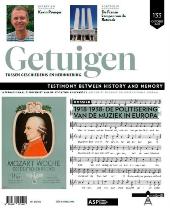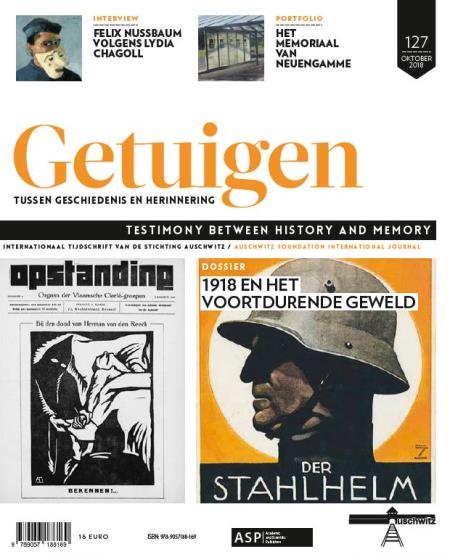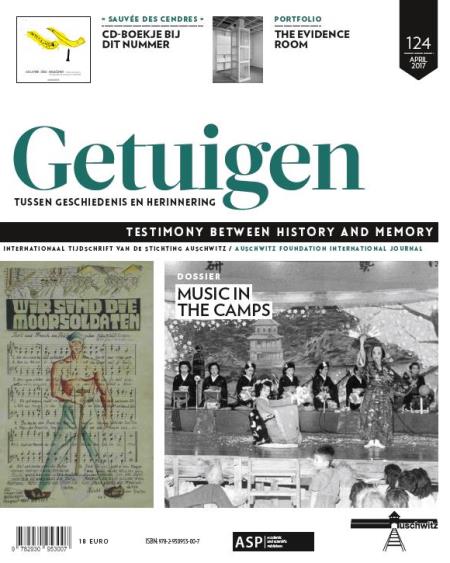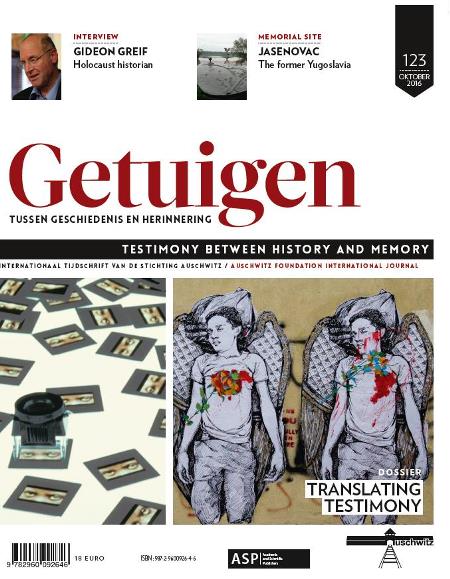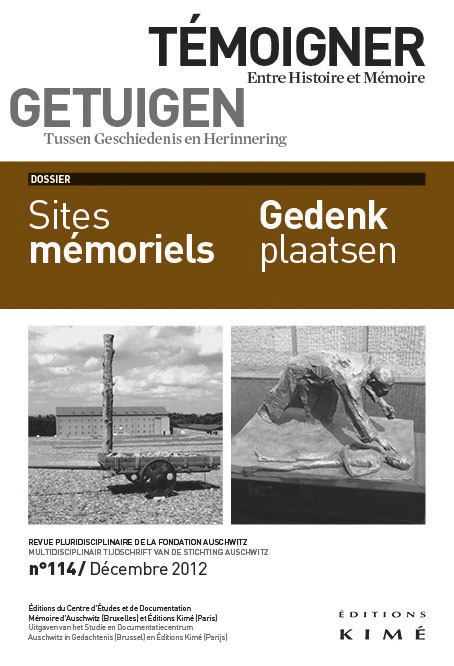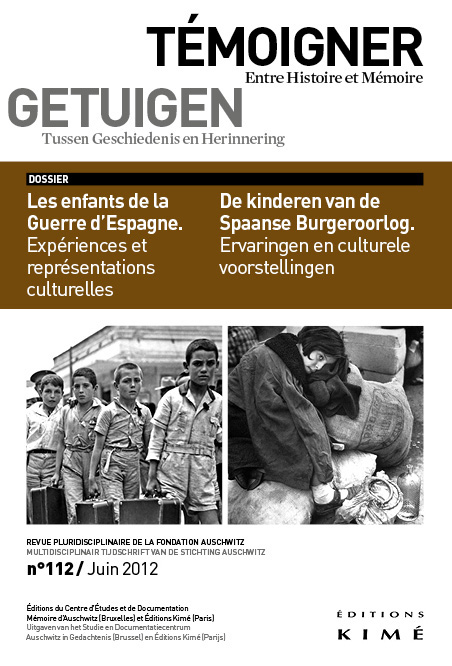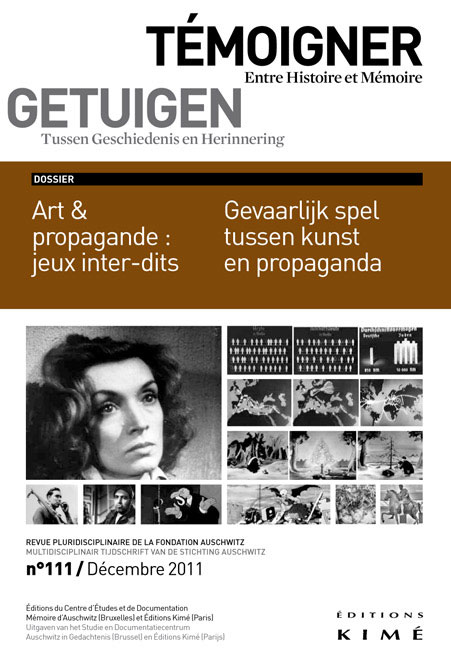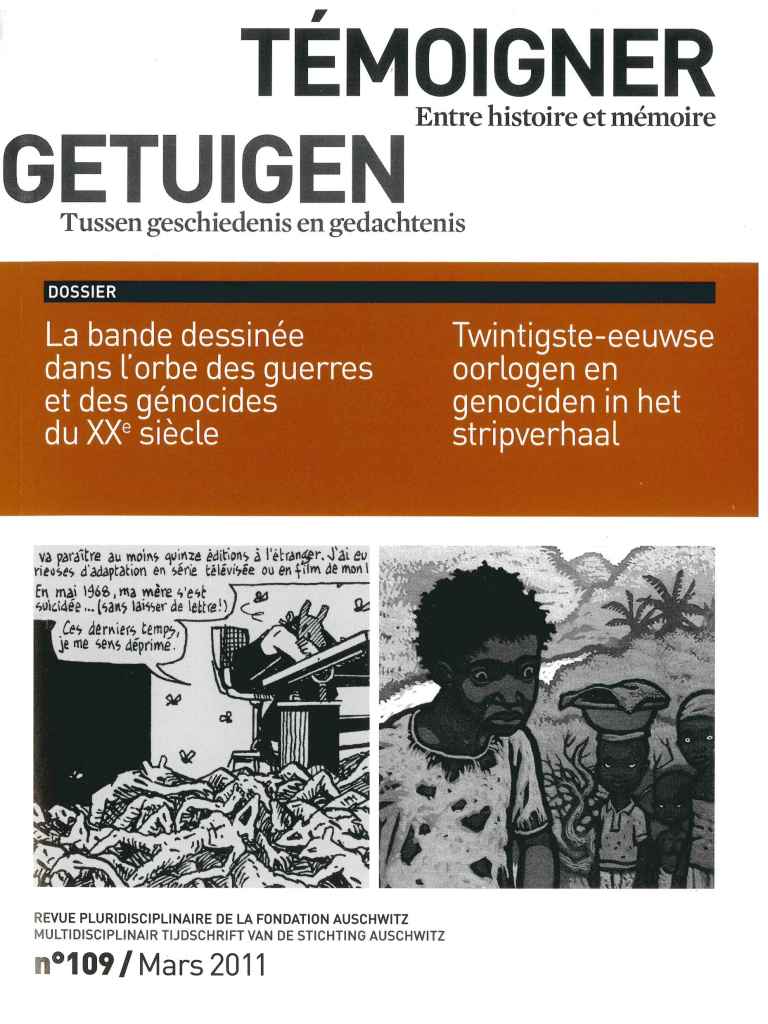Inhoudsopgave en samenvattingen nr. 123
- Film: Saul fia / Son of Saul. De doden spreken (Erik Machielsen)
Kun je de huiver van Auschwitz vertalen in een fictiefilm? Het antwoord luidt positief. Het pijnlijke maar krachtige bewijs daarvan wordt geleverd door Son of Saul.
- Film: Bridge of Spies. Helden in de schaduw (Erik Machielsen)
Werkelijk, nóg een film over de Koude Oorlog? Dat liedje kennen we ondertussen. Of toch niet? De namen van Steven Spielberg en Tom Hanks in de aftiteling prikkelen in ieder geval onze nieuwsgierigheid. Met achtentwintig films op zijn conto heeft Spielberg nog niets aan jeugdigheid ingeboet. Uit Bridge of Spies blijkt meer dan ooit zijn voorliefde voor helden in de schaduw, gewone mannen of vrouwen die worden gedreven door integriteit en eergevoel. - Theater: De Welwillenden (Anneleen Spiessens)
“Laat me u vertellen hoe het ging. Het is een trieste geschiedenis, maar toch ook een verhaal met een moraal. Een vrij lang verhaal, er heeft zich heel wat afgespeeld. Maar misschien bent u niet gehaast, misschien heeft u tijd. Ik zal er alles aan doen om duidelijk te blijven. U hebt de garantie dat in wat ik u ga vertellen geen enkele wroeging zal doorklinken. Ik heb nergens spijt van, ik deed mijn werk, meer niet.” Aan het woord is Max Aue, gespeeld door de Nederlandse acteur Hans Kesting. Als oude man blikt hij terug op zijn carrière bij de SD, later de SS, waar hij in het spoor van de Duitse Einsatzgruppen de ‘Holocaust door kogels’ aan het oostfront mee overzag en na een passage in Stalingrad naar Berlijn werd afgevaardigd om de inzet van gevangengenomen Joden in de oorlogseconomie te bestuderen. Vanop de bühne spreekt hij zijn publiek nu rechtstreeks toe. - Theater: Theatre as Courtroom: The NSU protocols in Freiburg (Tom Vanassche and Martin Hinze)
In 2015, the Freiburg Theatre initiated a series of “dramatic readings” based on the trial against the NSU (Nationalsozialistischer Untergrund), suspected of a series of racist murders in Germany. The NSU Protocols constitute in many ways a parallel trial that reveals both overt and latent forms of racism in German society and, by drawing on the “factographic” tradition of documentary theatre, specifically seek civic participation. - Muziek: Le Verfügbar aux enfers. Interview met Marion Pillé (interview afgenomen door Daniel Weyssow)
Op 21 oktober 1943 wordt Germaine Tillion wegens verzetsactiviteiten naar Ravensbrück gedeporteerd. Door de solidariteit van haar kameraden slaagt ze in oktober 1944 in een onvervalst waagstuk waar de doodstraf op staat, namelijk schrijven. Ze is ervan overtuigd dat humor en inzicht in hun omgeving voor de gedeporteerden de laatste bescherming bieden tegen ontmenselijking. Daarom beschrijft ze hun leefomstandigheden in een compromisloze operette: Le Verfügbar aux enfers. De operette wordt nu in november 2016 opgevoerd in het Brusselse Théâtre Marni. We hadden een gesprek met regisseur Marion Pillé, twee maanden nadat haar gezelschap Les Souffleuses de Chaos het work-in-progress voorstelde, meer bepaald op 11 november 2015 in het Maison de la Création. Op de uitnodiging prijkte volgende boodschap: ‘Op de met afgeschoren haren bestrooide arena van een macaber, wrang grappig circus zingen en dansen vier actrices in een poging om dood en barbarij te tarten.’
- Professor Gideon Greif is well-known for his pioneering research on the Sonderkommandos, prisoners who were forced to work in the gas chambers and crematoria of the Auschwitz-Birkenau concentration and extermination camp. Some of them moved to Israel afterwards. In 1986, when he realized that the matter had received very little attention until then, Greif began collecting interviews of these tormented men and managed to gather a unique collection of testimonies that conveys the voices of these unlikely survivors. Indeed, as “bearers of secrets” (Geheimnisträger) from the Nazi perpetrators, the men were not supposed to live and share their story. Last year, Gideon Greif and Itamar Levin published Aufstand in Auschwitz (2015), a study about the revolt of the Sonderkommandos in Birkenau on 7 October 1944 – an unexplored event. It was one of the numerous acts of resistance against the Nazis that the Jewish people undertook in occupied Europe.
Edited by Anneleen Spiessens and Tom Toremans
- Presentation (Anneleen Spiessens and Tom Toremans)
What is the relationship between testimony, defined as a more or less ritualized first-person account of political violence, and translation? Correspondingly, how does the translator position herself towards the witness? Can the translator be, or become, a witness? How, when and why are testimonies translated? Which linguistic and discursive strategies do translators resort to when faced with ethically challenging texts? Which role do they play exactly in the transmission of the historical knowledge, cultural values or social critique conveyed by the testimony? Does translation weaken or rather reinforce the relevance and impact of the original statement? How important is translation in literary, political and institutional settings? Do these specific settings determine translation practice in significant ways? To which extent can subsequent processes of transcription, editing, translation and archiving affect the source text? And how accurate are the boundaries we draw to distinguish witnessing from translating, documentary from literary testimony, the original from its translation? These are the main questions we intend to explore in our dossier. - Retranslating Rousset: English-Language Mediations of L’Univers concentrationnaire (Sharon Deane-Cox)
This article approaches the translation of concentration camp testimony through the optic of secondary witnessing in order to consider how translation, as an act of listening, might impact the preservation and transmission of the survivors’ account. A case study on the initial translation and retranslation of David Rousset’s L’Univers concentrationnaire in English will serve as the basis for exploring how the translators have attended to the survivor’s representation of the camps. It will also scrutinize paratextual material and translation reviews as a means of retracing some of the socio-cultural conditions of production of the two target texts, paying particular attention to how Rousset has been understood and received. - Voicing the Perpetrator’s Perspective: Translation and Mediation in Jean Hatzfeld’s Une saison de machettes (Anneleen Spiessens)
This paper draws on discourse analysis and narrative theory to uncover the strategies exploited by authors who voice the perpetrators’ perspectives on war and conflict. As an “extreme” form of literature on both a formal and an ethical level, perpetrators’ testimonies cannot be but a “relayed” and therefore layered story, calling for a particular mise en scène. The paper assesses the importance of testimonial scenography in Une Saison de machettes, an account written by former war reporter Jean Hatzfeld that presents transcribed interviews with Rwandan génocidaires. An analysis of excerpts from the English and Dutch translations of Hatzfeld’s book reveals the polyphonic nature of the killers’ testimony and subverts the idea of a “consonant” translation as promoted by Hatzfeld himself. - Archived Voices: Refiguring Three Women’s Testimonies Delivered to the South African Truth and Reconciliation Commission (Antjie Krog and Nosisi Mpolweni)
The South African Truth and Reconciliation Commission (TRC) executed a vital process of transitional justice in the 1990s. Its main task was to address the human rights abuses of the past through a process of truth and amnesty, using the testimonies of victims/survivors and amnesty applicants to gather information about the gross violations of human rights that had taken place under apartheid. Today, the consequences, effects, and failures of the commission are still being debated among scholars as well as among certain parts of the population. The three testimonies discussed in this paper were delivered during the first and second weeks of TRC hearings in 1996, before being transcribed, translated and archived. We want to explore the less obvious and more subtle refigurings that took place during the compilation of TRC testimonies, not only through the processes of translation and transcription, but also through narrating the event in a way that leaves central moments un-uttered. - Pushing Back: Witnesses and Translation in the Radovan Karadži? Trial (Ellen Elias-Bursa?)
In the trial of Radovan Karadži? before the International Criminal Tribunal for the former Yugoslavia, the degree to which witnesses for the Prosecution and the Defence engage during their testimony with translation and interpreting issues is a measure of their sense of agency. Karadži? uses his position as a self-representing accused to assert his dominance over the trial. Prosecution and Defence witnesses find ways through discussion of language-related issues to resist Karadži?’s language-related pressures. - The Belgian Asylum Interview: The Implications of Lingua Franca English Usage (Katrijn Maryns)
In institutional settings of globalization, labelled languages are generally preferred over multilingual repertoires and mobile language resources. Drawing on linguistic-ethnographic analysis of the way English is treated as an invariable “ad hoc” idiom in the Belgian asylum interview, this article demonstrates how institutional measures and routines relating to multilingualism fail to address the communicative needs and practices of the participants involved. I discuss how the divergent potentialities of the speakers’ linguistic repertoires reflect a remarkable inversion of client-gatekeeper resources in the way the participants with the least linguistic resources in the interview process eventually have the power to act as arbiters of what is or is not institutionally relevant for the case. - “The Wrath of the Goddess” and Other Acts of Doktori: Exorcising Colonial Possession in Translation (Christi A. Merrill)
If the testimonial genre is appropriated from colonial-era academic traditions, how may its translation into English intervene in the complex domestic politics of caste and gender inequities in India? I attempt a provisional answer by attending to the issues raised when translating the life story of Dalit feminist Kausalya Baisantry’s Dohra Abhishaap [Doubly Cursed] from Hindi, focusing particularly on a short ethnographic passage that describes different ways untouchable members of her community dealt with smallpox outbreaks, from exorcism to Western medicine (as “doktori”). I argue that Baisantry’s rhetoric up-ends the binaries of postcolonial studies and in the process complicates genealogies of “cultural translation” Talal Asad has critiqued, including his insight that anthropological rhetoric is predicated on fixed disparity between languages. - Translating the Egyptian Revolution:
- Translation, Testimony, Activism (an Interview with Samah Selim by Tom Toremans)
As an academic, translator and activist, Samah Selim has produced a body of work that is of particular relevance to this special issue on the relation between translation and testimony. More specifically, it is the turn from academic research on Arabic literature and translation to a more directly activist engagement with translation in the wake of the revolution in Egypt in 2011 that is of specific interest to this issue. Currently Associate Professor at the Department of African, Middle Eastern and South Asian Languages and Literatures at Rutgers University, Selim previously taught at Columbia University, Princeton University and the University of Aix-en-Provence. She is also co-director of the literature module of the Berlin-based postdoctoral research program, Europe in the Middle East; the Middle East in Europe. Her published research mainly concerns modern Arabic literature in Egypt and the Levant, and the politics of translation in (post)colonial contexts. In 2004 she published a monograph on The Novel and the Rural Imaginary in Egypt 1880-1995, which explored the relationship between the rise of the novel genre, the politics of nationalist representation and the peasant question in 20th century Egypt.
In addition, Selim produced translations of works by Yahya Taher Abdullah, Khaled Ziadeh, Mohamed Makhzangi and Jurji Zaydan. She was the first translator winning both the Banipal Prize and the Arkansas Prize for Arabic literary translation. In 2012, Selim’s engagement with translation took an activist turn when she became a member of the video subtitling unit of the non-profit collective Mosireen. Inspired by this multifaceted, academic-activist engagement with translation and testimony, we interviewed Samah via e-mail in July of this year. - Moments of clarity (Omar Robert Hamilton)
Omar Robert Hamilton is a film maker, writer and cultural organizer working in documentary and fiction. He helped found Cairo’s Mosireen collective and works on the documentation, archiving and the visual record of the Egyptian revolution in various ways. He is also founder of the annual Palestine Festival of Literature, which seeks to challenge Israel’s various apartheid policies and the international discourse surrounding them. His latest fiction short, Though I Know the River is Dry from 2013, won the Prix UIP (Rotterdam), Best Short from the Arab World (Abu Dhabi) and Best Short Film (Yerevan). Hamilton writes semi-regularly for Egyptian journalism collective Mada Masr and occasionally for the London Review of Books blog. His debut novel The City Always Wins, about the parts of the revolution you cannot capture in the archive, will be published in 2017. In the following piece, he writes in the most heartfelt way about his hopes and frustrations during and after the Egyptian Revolution.
- Translation, Testimony, Activism (an Interview with Samah Selim by Tom Toremans)
Varia
- The Italian Military Internees in Germany during World War II: Repatriation, Memory, Denial (Sabrina Frontera)
After the armistice of 8 September, more than 650,000 Italian soldiers who had refused to fight for the Axis were disarmed by the Wehrmacht and deported to the Reich for forced labour. Deprived of the “Prisoner of War” status, they were classified as “Italian military internees” (IMI). The first consequence of this decision was that the Red Cross and international authorities could not reach their camps in which, despite the Geneva Convention agreements, soldiers were employed in factories as “slaves”. Until today, their story remains largely untold.
The arrival of the Allies and the formal liberation of the camps was not the end of the IMI’s sufferings: considered displaced persons and sometimes suspected of collaboration, they were not immediately repatriated. On their return to Italy, moreover, they were heavily disappointed, faced with economic and practical problems in everyday life. The present article focuses not only on the history of repatriation but explores how the memory of internment was constructed and managed by the ex-internees, the institutions and political parties in Italy. - The Battle of Vukovar. A Turning Point in the Croatian “Homeland War” (Dražen Živi? and Iva Šuši? Degme?i?)
The year 2016 commemorates the 25th anniversary of what is referred to as “the Greater-Serbian aggression” against the then self-proclaimed Republic of Croatia and the town of Vukovar. Between 18 and 20 November 1991, after a three-month siege, the Yugoslav National Army and Serbian forces occupied Vukovar. They committed numerous war crimes, many of which were defined as the actus reus of genocide. Thousands of killed, wounded, displaced and missing persons as well as substantial material damage are a clear evidence of the urbicide, memoricide and culturecide committed by Serbian forces against an old, Croatian town. Vukovar became a symbol of Croatian defence in the “Homeland War”, and 1991 a crucial moment in the establishment and international recognition of an independent Croatian state.
Memorial Site
- The Memorial Centre of Homeland War Vukovar, Croatia (Iva Šuši? Degme?i?)
The article briefly traces the siege of Vukovar by the Yugoslav National Army in 1991 and the gruesome post-occupation events. It then focuses on the foundation of the Memorial Centre of Homeland War Vukovar in 2013, a site of remembrance, education, research and documentation where young generations get to know Vukovar’s past and learn about coexistence and tolerance. - Jasenovac: Een litteken in de Kroatische bodem (Frédéric Crahay)
Dit artikel schetst de geschiedenis van de site van Jasenovac en onderzoekt de redenen voor diens dalende populariteit vandaag. Tijdens de Tweede Wereldoorlog stond het concentratiekamp Jasenovac symbool voor de verschrikkingen de Ustašadictatuur in de Onafhankelijke Staat Kroatië. Na de bevrijding door Tito werd een bezoek aan de plek verplicht voor scholieren. In 1965 werd er een memoriaal opgericht. Na de oorlog van 1991 raakte de site echter in verval. De Kroatische staat zet nu voornamelijk in op Vukovar, omdat Jasenovac herinnert aan een pijnlijk en crimineel verleden. De opkomst van nationalistische partijen en Ustašasymbolen in Kroatië vandaag wijzen echter op het grote belang van Jasenovac als herinneringsplek.
Boekenplank
- Alexandre Doulut, Serge Klarsfeld & Sandrine Labeau (red.), 1945. Les rescapés juifs d’Auschwitz témoignent, Paris: Les fils et filles des déportés juifs de France – Après l’oubli, 2015. (Paul Bernard-Nouraud)
- Christopher Clark, Ijzeren koninkrijk. Opkomst en ondergang van Pruisen 1600-1947, Vertaald uit het Engels door Wil Hansen, Amsterdam: De Bezige Bij, 2015, 850 p. (Brecht Capiau)
- Élise Fontenaille-N’Diaye, Blue Book, Parijs: Calmann-Lévy, 2015, 209 p. (Jean-Pierre Pisetta)
- Sandra Ponzanesi, Postcolonial Cultural Industry: Icons, Markets, Mythologies, Palgrave Macmillan, 2014, 272 p. (Caterina Romeo)
- Ma?gorzata Pakier & Joanna Wawrzyniak (eds.), Memory and Change in Europe: Eastern Perspectives, New York & Oxford: Berghahn, 2016, xiv + 373 p. (Sara Jones)
- Nadia Butt, Transcultural Memory and Globalised Modernity in Contemporary Indo-English Novels, Berlin and Boston: de Gruyter, 2015, 213 p. (Sayma Khan)
Herinneringslabo
- Seyfo 1915 – Rwanda 94. Een sprankje hoop voor de ‘herinnering’ in België? (Mélanie Moreas)
De auteur reflecteer over (het gebrek aan) herinneringsplekken in Brussel aan de genocide op de Tutsi’s, en bezoekt het Assyrische monument in het heiligdom Banneux/Louveigné bij Luik en het Aramese monument naast de Sint-Pieterskerk in Jette. Opdat de herinnering aan het verleden vorm kan geven aan een betere toekomst, moet nagedacht worden over drie fundamentele uitdagingen: de democratische, politieke en opvoedkundige.
Contact
Stichting Auschwitz – vzw Auschwitz in Gedachtenis
Wolstraat 17/Bus 50 – B-1000 Brussel +32 (0)2 512 79 98
+32 (0)2 512 79 98 info@auschwitz.be
info@auschwitz.be
KBO Stichting Auschwitz: 0876787354
KBO Auschwitz in Gedachtenis: 0420667323
Kantoren geopend van maandag t/m vrijdag tussen 9u30 en 16u30.
Raadpleging ter plaatse enkel op afspraak.![]()
![]()
![]()
![]()
![]()
Lidmaatschap
Wilt u lid worden van de vzw Auschwitz in Gedachtenis? Contacteer ons en stort vervolgens € 50,00 op rekeningnummer IBAN BE55 3100 7805 1744 – BIC BBRUBEBB met als melding ‘Lidmaatschap 2025’. Het lidmaatschap geeft u recht op de twee nummers van ons wetenschappelijk tijdschrift Getuigen: Tussen geschiedenis en herinnering voor 2025.
GIFTEN
Bovendien geeft elke gift van € 40,00 of meer (in een of meerdere schijven) Belgische belastingbetalers recht op belastingvermindering.
Vermeld in de melding dat het om een ‘Gift’ gaat en vermeld uw rijksregisternummer. Dit is verplicht sinds 2024 om van de vermindering te kunnen genieten.









